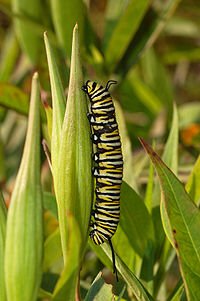
Photo from wikipedia
Within a species, individual animals adopt various defensive strategies to resist natural enemies, but the defensive strategies that are adopted in response to variations in predation risk are poorly understood.… Click to show full abstract
Within a species, individual animals adopt various defensive strategies to resist natural enemies, but the defensive strategies that are adopted in response to variations in predation risk are poorly understood. Here, we assessed consecutive foraging processes on cohorts of two biotypes (green and red) of the pea aphid, Acyrthosiphon pisum, by the predatory lady beetle Propylea japonica, to investigate the adaptive mechanism underlying the defensive strategy. We observed the behavioral responses of individuals (continue feeding or escape, i.e., walk away or drop off from initial feeding site), simultaneously quantified the amount of alarm pheromone, (E)-β-farnesene (EβF) released from cohorts using gas chromatography-mass spectrometry (GC-MS), and recorded the foraging times of predators in intervals. The results indicated that: (1) the anti-predator responses differed markedly between biotypes and among the stages of the consecutive foraging processes. (2) Few green cohorts tended to release EβF during the first foraging; those that did released only a low dose that did not increase the number of escapes. However, the amount of EβF rose rapidly following the second foraging process, which caused an intense escape response. In contrast, more red cohorts released greater amounts of EβF, which caused more individuals to escape from their innate feeding sites during the first foraging. During the second foraging, more red individuals tended to escape without releasing EβF in greater quantities. (3) The foraging time was effectively shortened in each biotype cohort that adopted diverse defensive strategies. This study of the defensive strategies of the pea aphid may contribute to understanding the intraspecific differences in aphid defense mechanisms.
Journal Title: Journal of Chemical Ecology
Year Published: 2017
Link to full text (if available)
Share on Social Media: Sign Up to like & get
recommendations!